CNA408 - Personal Practice Improvement: Mrs. Brown Case Study
VerifiedAdded on 2020/03/04
|11
|2610
|114
Practical Assignment
AI Summary
This assignment presents a detailed case study of Mrs. Brown, a 67-year-old patient admitted to the hospital with a hip fracture, obesity, hypertension, and osteoarthritis. The student analyzes Mrs. Brown's condition, applying the clinical reasoning cycle to assess her situation, process information, identify problems, establish goals, take action through interventions like infection control, pain management, diet, and counseling, and finally, evaluate outcomes. The assignment emphasizes the importance of a patient-centered approach, therapeutic relationships, and family education to improve Mrs. Brown's physical and emotional well-being, aiming to prevent complications, manage pain, and promote independence. The student also reflects on the application of the clinical reasoning cycle in developing the care plan and the overall impact on patient outcomes. The assignment highlights the need for individualized care, considering the patient's physical and emotional state, and the integration of evidence-based practices to improve patient outcomes. The student uses the clinical reasoning cycle to systematically address Mrs. Brown's complex needs, emphasizing the importance of a holistic approach in patient care.
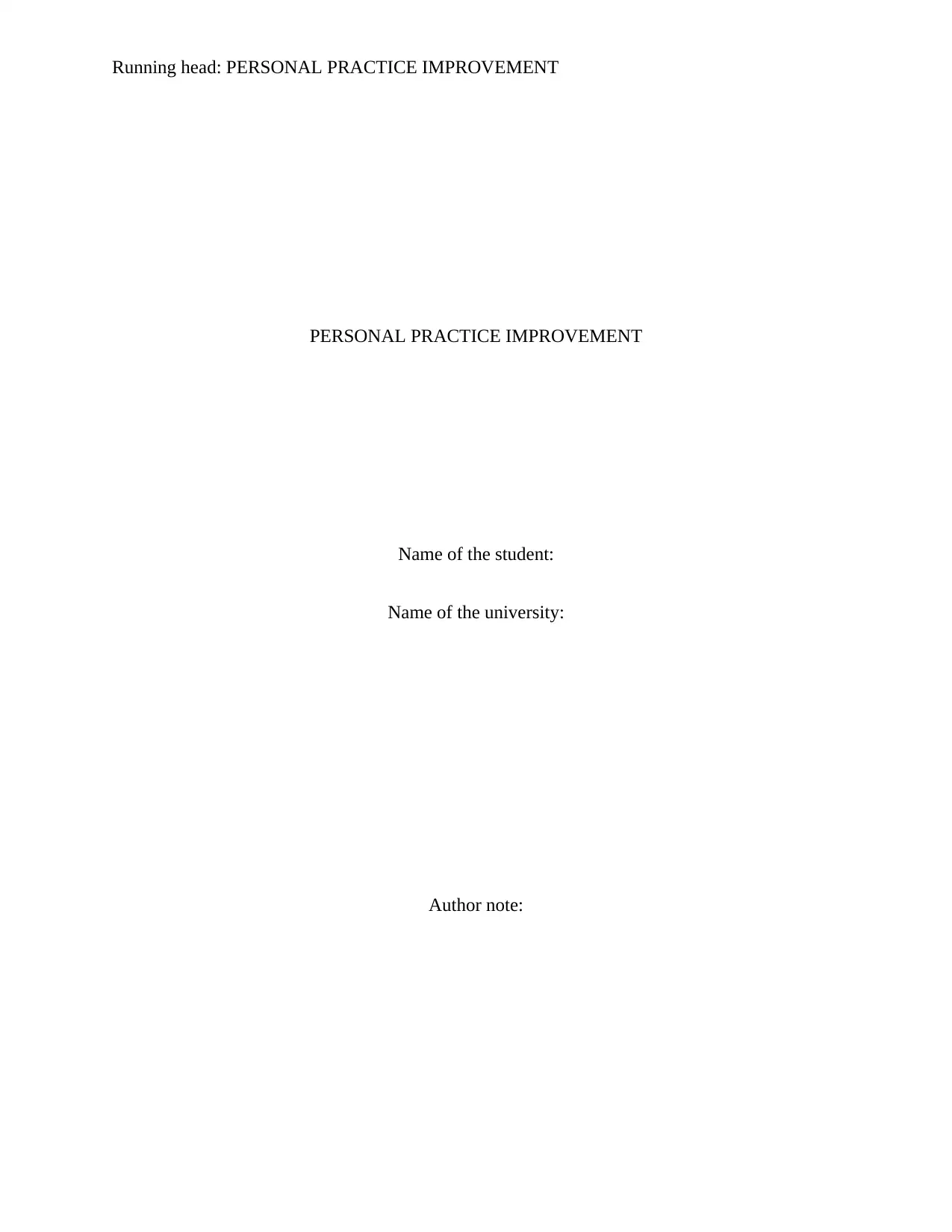
Running head: PERSONAL PRACTICE IMPROVEMENT
PERSONAL PRACTICE IMPROVEMENT
Name of the student:
Name of the university:
Author note:
PERSONAL PRACTICE IMPROVEMENT
Name of the student:
Name of the university:
Author note:
Paraphrase This Document
Need a fresh take? Get an instant paraphrase of this document with our AI Paraphraser
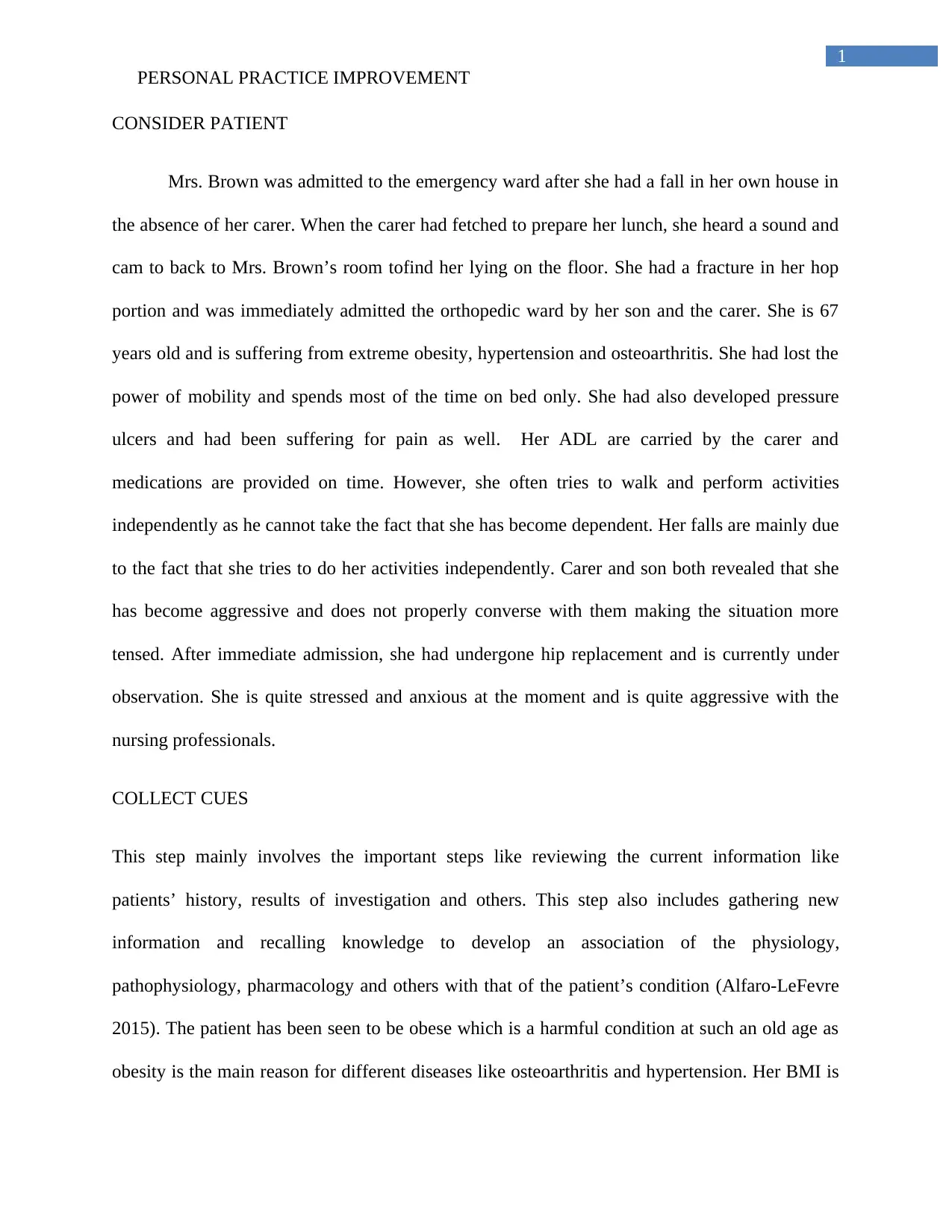
1
PERSONAL PRACTICE IMPROVEMENT
CONSIDER PATIENT
Mrs. Brown was admitted to the emergency ward after she had a fall in her own house in
the absence of her carer. When the carer had fetched to prepare her lunch, she heard a sound and
cam to back to Mrs. Brown’s room tofind her lying on the floor. She had a fracture in her hop
portion and was immediately admitted the orthopedic ward by her son and the carer. She is 67
years old and is suffering from extreme obesity, hypertension and osteoarthritis. She had lost the
power of mobility and spends most of the time on bed only. She had also developed pressure
ulcers and had been suffering for pain as well. Her ADL are carried by the carer and
medications are provided on time. However, she often tries to walk and perform activities
independently as he cannot take the fact that she has become dependent. Her falls are mainly due
to the fact that she tries to do her activities independently. Carer and son both revealed that she
has become aggressive and does not properly converse with them making the situation more
tensed. After immediate admission, she had undergone hip replacement and is currently under
observation. She is quite stressed and anxious at the moment and is quite aggressive with the
nursing professionals.
COLLECT CUES
This step mainly involves the important steps like reviewing the current information like
patients’ history, results of investigation and others. This step also includes gathering new
information and recalling knowledge to develop an association of the physiology,
pathophysiology, pharmacology and others with that of the patient’s condition (Alfaro-LeFevre
2015). The patient has been seen to be obese which is a harmful condition at such an old age as
obesity is the main reason for different diseases like osteoarthritis and hypertension. Her BMI is
PERSONAL PRACTICE IMPROVEMENT
CONSIDER PATIENT
Mrs. Brown was admitted to the emergency ward after she had a fall in her own house in
the absence of her carer. When the carer had fetched to prepare her lunch, she heard a sound and
cam to back to Mrs. Brown’s room tofind her lying on the floor. She had a fracture in her hop
portion and was immediately admitted the orthopedic ward by her son and the carer. She is 67
years old and is suffering from extreme obesity, hypertension and osteoarthritis. She had lost the
power of mobility and spends most of the time on bed only. She had also developed pressure
ulcers and had been suffering for pain as well. Her ADL are carried by the carer and
medications are provided on time. However, she often tries to walk and perform activities
independently as he cannot take the fact that she has become dependent. Her falls are mainly due
to the fact that she tries to do her activities independently. Carer and son both revealed that she
has become aggressive and does not properly converse with them making the situation more
tensed. After immediate admission, she had undergone hip replacement and is currently under
observation. She is quite stressed and anxious at the moment and is quite aggressive with the
nursing professionals.
COLLECT CUES
This step mainly involves the important steps like reviewing the current information like
patients’ history, results of investigation and others. This step also includes gathering new
information and recalling knowledge to develop an association of the physiology,
pathophysiology, pharmacology and others with that of the patient’s condition (Alfaro-LeFevre
2015). The patient has been seen to be obese which is a harmful condition at such an old age as
obesity is the main reason for different diseases like osteoarthritis and hypertension. Her BMI is
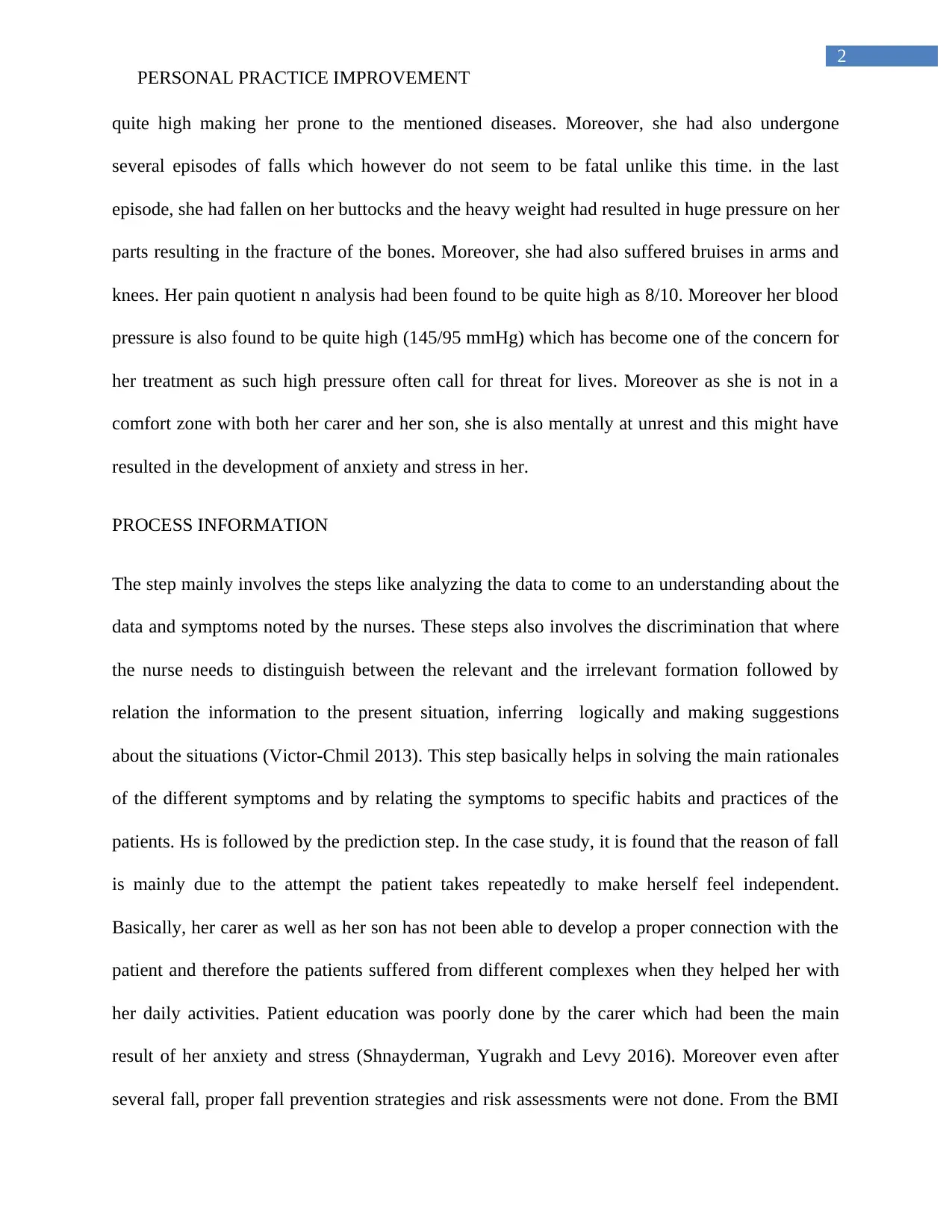
2
PERSONAL PRACTICE IMPROVEMENT
quite high making her prone to the mentioned diseases. Moreover, she had also undergone
several episodes of falls which however do not seem to be fatal unlike this time. in the last
episode, she had fallen on her buttocks and the heavy weight had resulted in huge pressure on her
parts resulting in the fracture of the bones. Moreover, she had also suffered bruises in arms and
knees. Her pain quotient n analysis had been found to be quite high as 8/10. Moreover her blood
pressure is also found to be quite high (145/95 mmHg) which has become one of the concern for
her treatment as such high pressure often call for threat for lives. Moreover as she is not in a
comfort zone with both her carer and her son, she is also mentally at unrest and this might have
resulted in the development of anxiety and stress in her.
PROCESS INFORMATION
The step mainly involves the steps like analyzing the data to come to an understanding about the
data and symptoms noted by the nurses. These steps also involves the discrimination that where
the nurse needs to distinguish between the relevant and the irrelevant formation followed by
relation the information to the present situation, inferring logically and making suggestions
about the situations (Victor-Chmil 2013). This step basically helps in solving the main rationales
of the different symptoms and by relating the symptoms to specific habits and practices of the
patients. Hs is followed by the prediction step. In the case study, it is found that the reason of fall
is mainly due to the attempt the patient takes repeatedly to make herself feel independent.
Basically, her carer as well as her son has not been able to develop a proper connection with the
patient and therefore the patients suffered from different complexes when they helped her with
her daily activities. Patient education was poorly done by the carer which had been the main
result of her anxiety and stress (Shnayderman, Yugrakh and Levy 2016). Moreover even after
several fall, proper fall prevention strategies and risk assessments were not done. From the BMI
PERSONAL PRACTICE IMPROVEMENT
quite high making her prone to the mentioned diseases. Moreover, she had also undergone
several episodes of falls which however do not seem to be fatal unlike this time. in the last
episode, she had fallen on her buttocks and the heavy weight had resulted in huge pressure on her
parts resulting in the fracture of the bones. Moreover, she had also suffered bruises in arms and
knees. Her pain quotient n analysis had been found to be quite high as 8/10. Moreover her blood
pressure is also found to be quite high (145/95 mmHg) which has become one of the concern for
her treatment as such high pressure often call for threat for lives. Moreover as she is not in a
comfort zone with both her carer and her son, she is also mentally at unrest and this might have
resulted in the development of anxiety and stress in her.
PROCESS INFORMATION
The step mainly involves the steps like analyzing the data to come to an understanding about the
data and symptoms noted by the nurses. These steps also involves the discrimination that where
the nurse needs to distinguish between the relevant and the irrelevant formation followed by
relation the information to the present situation, inferring logically and making suggestions
about the situations (Victor-Chmil 2013). This step basically helps in solving the main rationales
of the different symptoms and by relating the symptoms to specific habits and practices of the
patients. Hs is followed by the prediction step. In the case study, it is found that the reason of fall
is mainly due to the attempt the patient takes repeatedly to make herself feel independent.
Basically, her carer as well as her son has not been able to develop a proper connection with the
patient and therefore the patients suffered from different complexes when they helped her with
her daily activities. Patient education was poorly done by the carer which had been the main
result of her anxiety and stress (Shnayderman, Yugrakh and Levy 2016). Moreover even after
several fall, proper fall prevention strategies and risk assessments were not done. From the BMI
⊘ This is a preview!⊘
Do you want full access?
Subscribe today to unlock all pages.

Trusted by 1+ million students worldwide
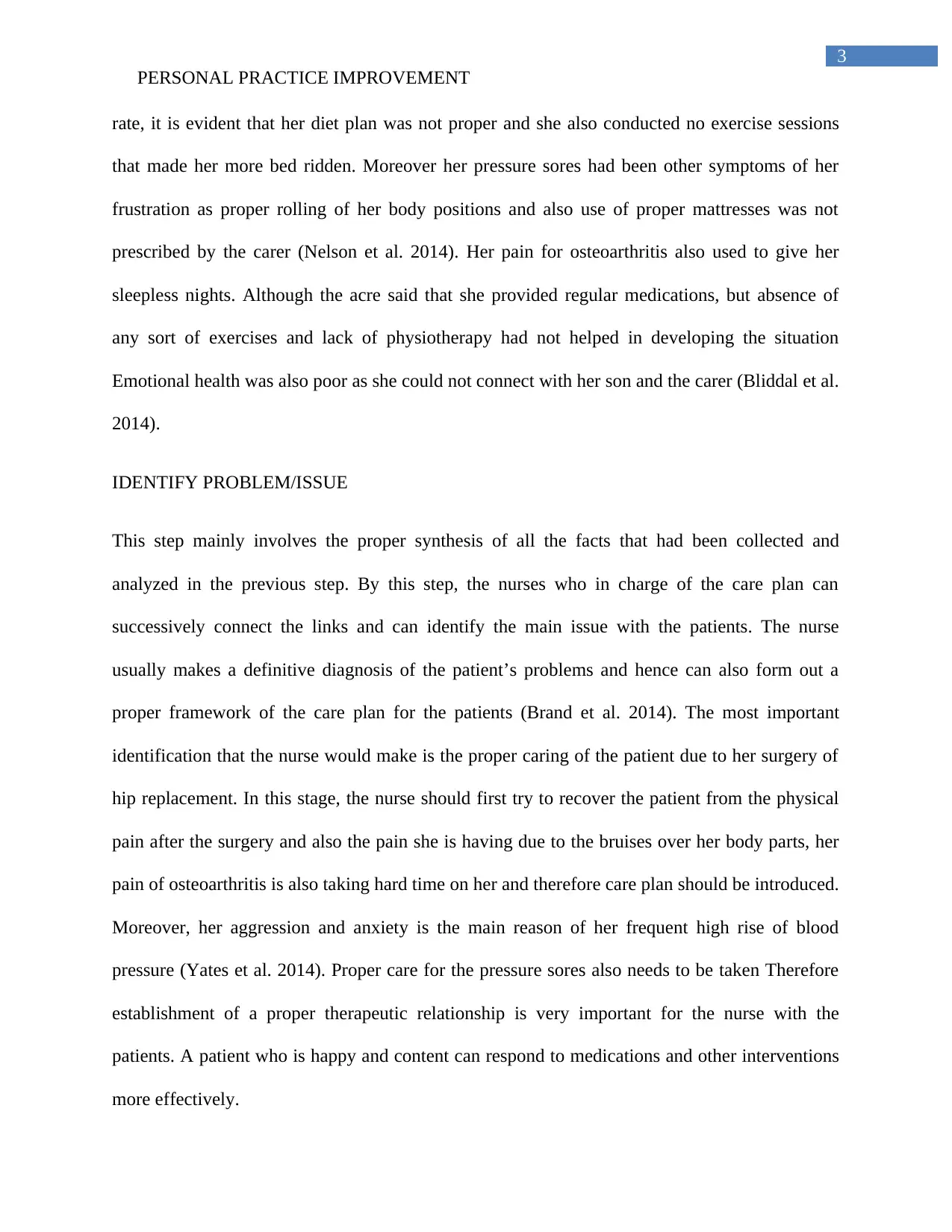
3
PERSONAL PRACTICE IMPROVEMENT
rate, it is evident that her diet plan was not proper and she also conducted no exercise sessions
that made her more bed ridden. Moreover her pressure sores had been other symptoms of her
frustration as proper rolling of her body positions and also use of proper mattresses was not
prescribed by the carer (Nelson et al. 2014). Her pain for osteoarthritis also used to give her
sleepless nights. Although the acre said that she provided regular medications, but absence of
any sort of exercises and lack of physiotherapy had not helped in developing the situation
Emotional health was also poor as she could not connect with her son and the carer (Bliddal et al.
2014).
IDENTIFY PROBLEM/ISSUE
This step mainly involves the proper synthesis of all the facts that had been collected and
analyzed in the previous step. By this step, the nurses who in charge of the care plan can
successively connect the links and can identify the main issue with the patients. The nurse
usually makes a definitive diagnosis of the patient’s problems and hence can also form out a
proper framework of the care plan for the patients (Brand et al. 2014). The most important
identification that the nurse would make is the proper caring of the patient due to her surgery of
hip replacement. In this stage, the nurse should first try to recover the patient from the physical
pain after the surgery and also the pain she is having due to the bruises over her body parts, her
pain of osteoarthritis is also taking hard time on her and therefore care plan should be introduced.
Moreover, her aggression and anxiety is the main reason of her frequent high rise of blood
pressure (Yates et al. 2014). Proper care for the pressure sores also needs to be taken Therefore
establishment of a proper therapeutic relationship is very important for the nurse with the
patients. A patient who is happy and content can respond to medications and other interventions
more effectively.
PERSONAL PRACTICE IMPROVEMENT
rate, it is evident that her diet plan was not proper and she also conducted no exercise sessions
that made her more bed ridden. Moreover her pressure sores had been other symptoms of her
frustration as proper rolling of her body positions and also use of proper mattresses was not
prescribed by the carer (Nelson et al. 2014). Her pain for osteoarthritis also used to give her
sleepless nights. Although the acre said that she provided regular medications, but absence of
any sort of exercises and lack of physiotherapy had not helped in developing the situation
Emotional health was also poor as she could not connect with her son and the carer (Bliddal et al.
2014).
IDENTIFY PROBLEM/ISSUE
This step mainly involves the proper synthesis of all the facts that had been collected and
analyzed in the previous step. By this step, the nurses who in charge of the care plan can
successively connect the links and can identify the main issue with the patients. The nurse
usually makes a definitive diagnosis of the patient’s problems and hence can also form out a
proper framework of the care plan for the patients (Brand et al. 2014). The most important
identification that the nurse would make is the proper caring of the patient due to her surgery of
hip replacement. In this stage, the nurse should first try to recover the patient from the physical
pain after the surgery and also the pain she is having due to the bruises over her body parts, her
pain of osteoarthritis is also taking hard time on her and therefore care plan should be introduced.
Moreover, her aggression and anxiety is the main reason of her frequent high rise of blood
pressure (Yates et al. 2014). Proper care for the pressure sores also needs to be taken Therefore
establishment of a proper therapeutic relationship is very important for the nurse with the
patients. A patient who is happy and content can respond to medications and other interventions
more effectively.
Paraphrase This Document
Need a fresh take? Get an instant paraphrase of this document with our AI Paraphraser
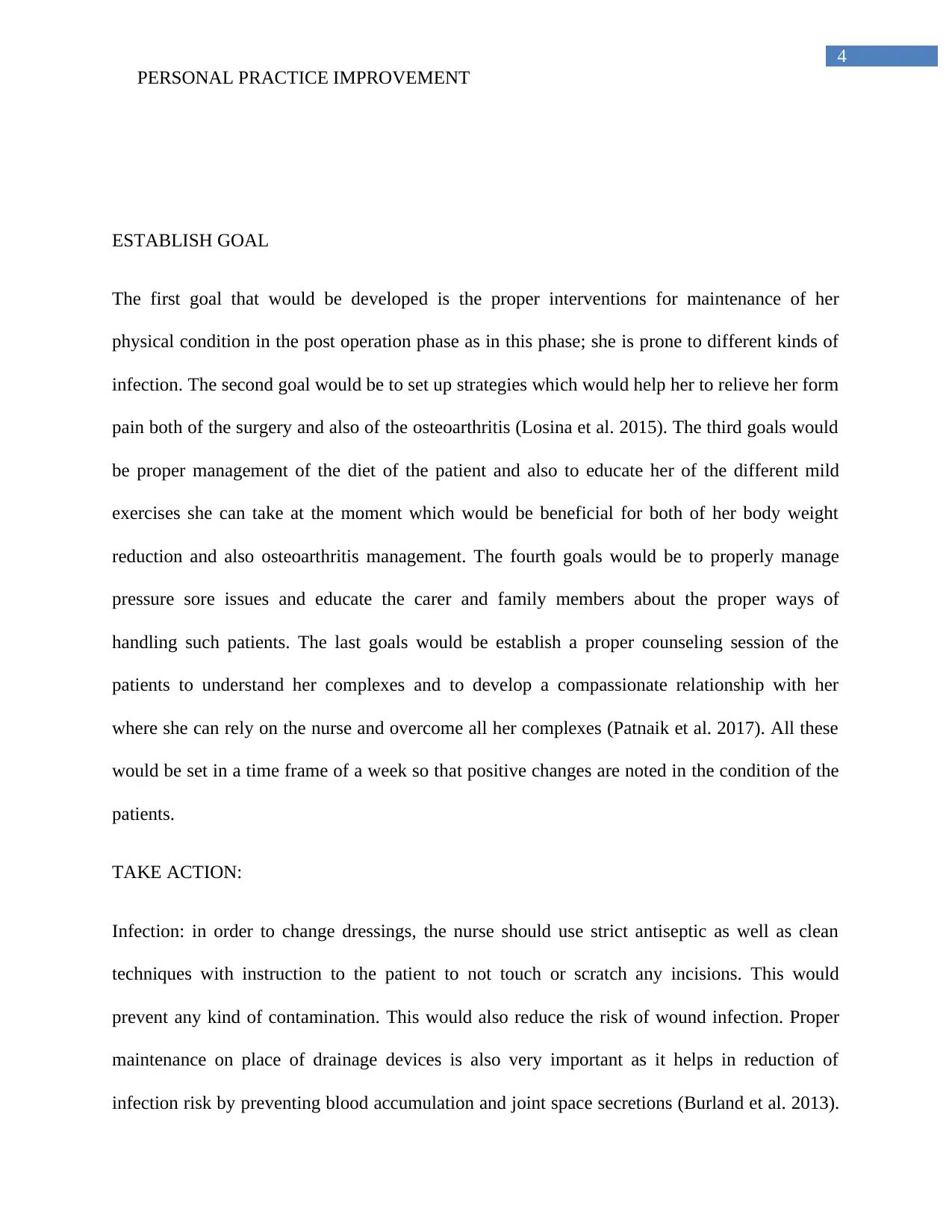
4
PERSONAL PRACTICE IMPROVEMENT
ESTABLISH GOAL
The first goal that would be developed is the proper interventions for maintenance of her
physical condition in the post operation phase as in this phase; she is prone to different kinds of
infection. The second goal would be to set up strategies which would help her to relieve her form
pain both of the surgery and also of the osteoarthritis (Losina et al. 2015). The third goals would
be proper management of the diet of the patient and also to educate her of the different mild
exercises she can take at the moment which would be beneficial for both of her body weight
reduction and also osteoarthritis management. The fourth goals would be to properly manage
pressure sore issues and educate the carer and family members about the proper ways of
handling such patients. The last goals would be establish a proper counseling session of the
patients to understand her complexes and to develop a compassionate relationship with her
where she can rely on the nurse and overcome all her complexes (Patnaik et al. 2017). All these
would be set in a time frame of a week so that positive changes are noted in the condition of the
patients.
TAKE ACTION:
Infection: in order to change dressings, the nurse should use strict antiseptic as well as clean
techniques with instruction to the patient to not touch or scratch any incisions. This would
prevent any kind of contamination. This would also reduce the risk of wound infection. Proper
maintenance on place of drainage devices is also very important as it helps in reduction of
infection risk by preventing blood accumulation and joint space secretions (Burland et al. 2013).
PERSONAL PRACTICE IMPROVEMENT
ESTABLISH GOAL
The first goal that would be developed is the proper interventions for maintenance of her
physical condition in the post operation phase as in this phase; she is prone to different kinds of
infection. The second goal would be to set up strategies which would help her to relieve her form
pain both of the surgery and also of the osteoarthritis (Losina et al. 2015). The third goals would
be proper management of the diet of the patient and also to educate her of the different mild
exercises she can take at the moment which would be beneficial for both of her body weight
reduction and also osteoarthritis management. The fourth goals would be to properly manage
pressure sore issues and educate the carer and family members about the proper ways of
handling such patients. The last goals would be establish a proper counseling session of the
patients to understand her complexes and to develop a compassionate relationship with her
where she can rely on the nurse and overcome all her complexes (Patnaik et al. 2017). All these
would be set in a time frame of a week so that positive changes are noted in the condition of the
patients.
TAKE ACTION:
Infection: in order to change dressings, the nurse should use strict antiseptic as well as clean
techniques with instruction to the patient to not touch or scratch any incisions. This would
prevent any kind of contamination. This would also reduce the risk of wound infection. Proper
maintenance on place of drainage devices is also very important as it helps in reduction of
infection risk by preventing blood accumulation and joint space secretions (Burland et al. 2013).
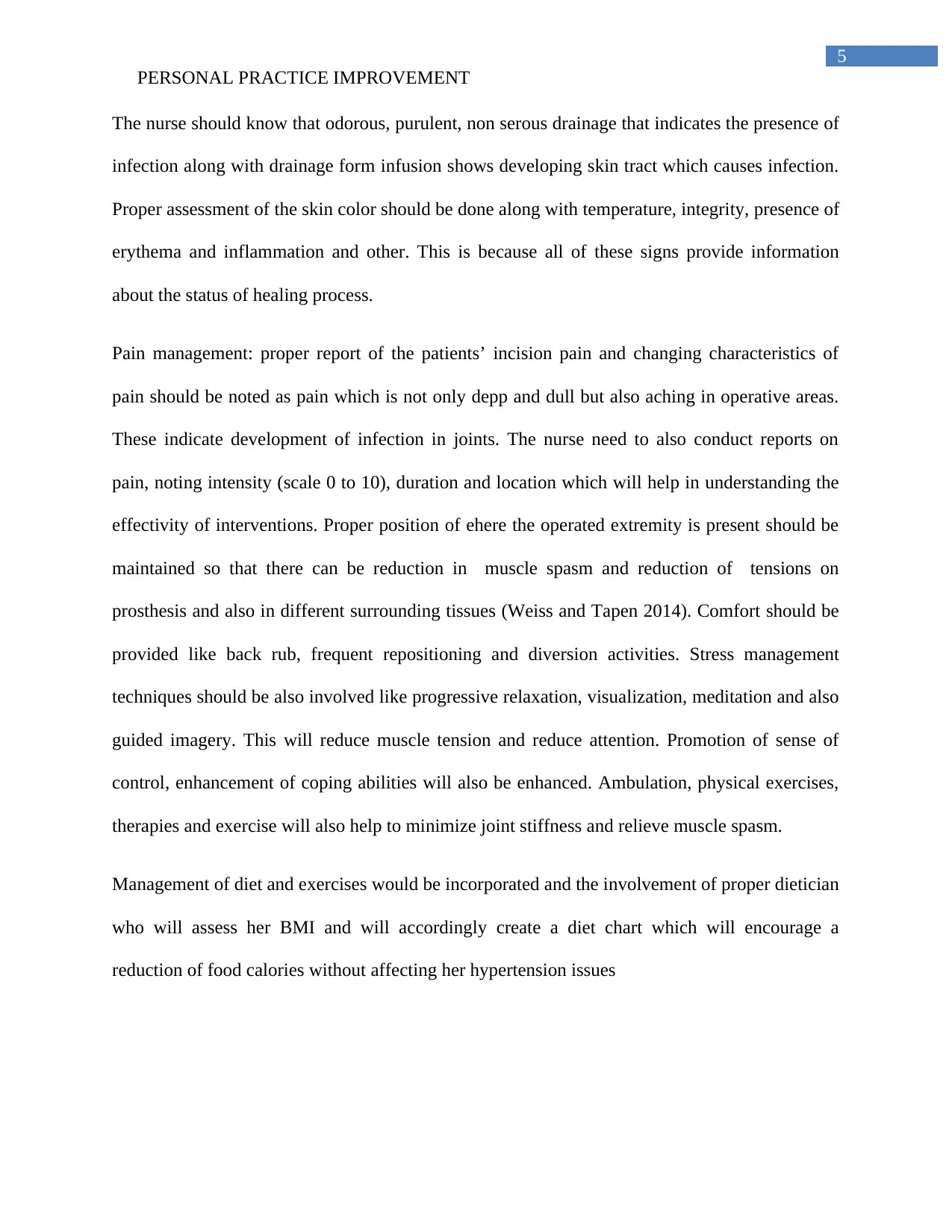
5
PERSONAL PRACTICE IMPROVEMENT
The nurse should know that odorous, purulent, non serous drainage that indicates the presence of
infection along with drainage form infusion shows developing skin tract which causes infection.
Proper assessment of the skin color should be done along with temperature, integrity, presence of
erythema and inflammation and other. This is because all of these signs provide information
about the status of healing process.
Pain management: proper report of the patients’ incision pain and changing characteristics of
pain should be noted as pain which is not only depp and dull but also aching in operative areas.
These indicate development of infection in joints. The nurse need to also conduct reports on
pain, noting intensity (scale 0 to 10), duration and location which will help in understanding the
effectivity of interventions. Proper position of ehere the operated extremity is present should be
maintained so that there can be reduction in muscle spasm and reduction of tensions on
prosthesis and also in different surrounding tissues (Weiss and Tapen 2014). Comfort should be
provided like back rub, frequent repositioning and diversion activities. Stress management
techniques should be also involved like progressive relaxation, visualization, meditation and also
guided imagery. This will reduce muscle tension and reduce attention. Promotion of sense of
control, enhancement of coping abilities will also be enhanced. Ambulation, physical exercises,
therapies and exercise will also help to minimize joint stiffness and relieve muscle spasm.
Management of diet and exercises would be incorporated and the involvement of proper dietician
who will assess her BMI and will accordingly create a diet chart which will encourage a
reduction of food calories without affecting her hypertension issues
PERSONAL PRACTICE IMPROVEMENT
The nurse should know that odorous, purulent, non serous drainage that indicates the presence of
infection along with drainage form infusion shows developing skin tract which causes infection.
Proper assessment of the skin color should be done along with temperature, integrity, presence of
erythema and inflammation and other. This is because all of these signs provide information
about the status of healing process.
Pain management: proper report of the patients’ incision pain and changing characteristics of
pain should be noted as pain which is not only depp and dull but also aching in operative areas.
These indicate development of infection in joints. The nurse need to also conduct reports on
pain, noting intensity (scale 0 to 10), duration and location which will help in understanding the
effectivity of interventions. Proper position of ehere the operated extremity is present should be
maintained so that there can be reduction in muscle spasm and reduction of tensions on
prosthesis and also in different surrounding tissues (Weiss and Tapen 2014). Comfort should be
provided like back rub, frequent repositioning and diversion activities. Stress management
techniques should be also involved like progressive relaxation, visualization, meditation and also
guided imagery. This will reduce muscle tension and reduce attention. Promotion of sense of
control, enhancement of coping abilities will also be enhanced. Ambulation, physical exercises,
therapies and exercise will also help to minimize joint stiffness and relieve muscle spasm.
Management of diet and exercises would be incorporated and the involvement of proper dietician
who will assess her BMI and will accordingly create a diet chart which will encourage a
reduction of food calories without affecting her hypertension issues
⊘ This is a preview!⊘
Do you want full access?
Subscribe today to unlock all pages.

Trusted by 1+ million students worldwide
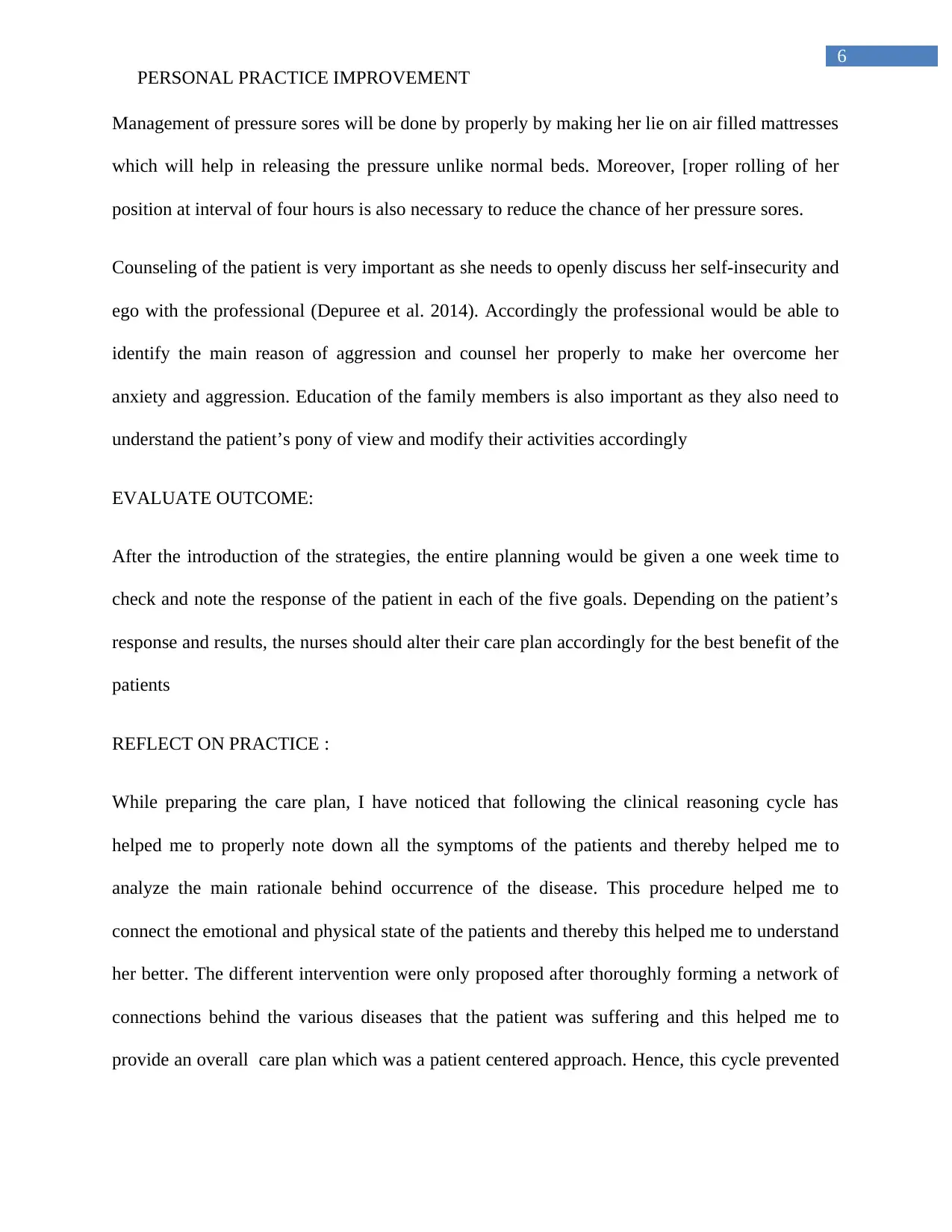
6
PERSONAL PRACTICE IMPROVEMENT
Management of pressure sores will be done by properly by making her lie on air filled mattresses
which will help in releasing the pressure unlike normal beds. Moreover, [roper rolling of her
position at interval of four hours is also necessary to reduce the chance of her pressure sores.
Counseling of the patient is very important as she needs to openly discuss her self-insecurity and
ego with the professional (Depuree et al. 2014). Accordingly the professional would be able to
identify the main reason of aggression and counsel her properly to make her overcome her
anxiety and aggression. Education of the family members is also important as they also need to
understand the patient’s pony of view and modify their activities accordingly
EVALUATE OUTCOME:
After the introduction of the strategies, the entire planning would be given a one week time to
check and note the response of the patient in each of the five goals. Depending on the patient’s
response and results, the nurses should alter their care plan accordingly for the best benefit of the
patients
REFLECT ON PRACTICE :
While preparing the care plan, I have noticed that following the clinical reasoning cycle has
helped me to properly note down all the symptoms of the patients and thereby helped me to
analyze the main rationale behind occurrence of the disease. This procedure helped me to
connect the emotional and physical state of the patients and thereby this helped me to understand
her better. The different intervention were only proposed after thoroughly forming a network of
connections behind the various diseases that the patient was suffering and this helped me to
provide an overall care plan which was a patient centered approach. Hence, this cycle prevented
PERSONAL PRACTICE IMPROVEMENT
Management of pressure sores will be done by properly by making her lie on air filled mattresses
which will help in releasing the pressure unlike normal beds. Moreover, [roper rolling of her
position at interval of four hours is also necessary to reduce the chance of her pressure sores.
Counseling of the patient is very important as she needs to openly discuss her self-insecurity and
ego with the professional (Depuree et al. 2014). Accordingly the professional would be able to
identify the main reason of aggression and counsel her properly to make her overcome her
anxiety and aggression. Education of the family members is also important as they also need to
understand the patient’s pony of view and modify their activities accordingly
EVALUATE OUTCOME:
After the introduction of the strategies, the entire planning would be given a one week time to
check and note the response of the patient in each of the five goals. Depending on the patient’s
response and results, the nurses should alter their care plan accordingly for the best benefit of the
patients
REFLECT ON PRACTICE :
While preparing the care plan, I have noticed that following the clinical reasoning cycle has
helped me to properly note down all the symptoms of the patients and thereby helped me to
analyze the main rationale behind occurrence of the disease. This procedure helped me to
connect the emotional and physical state of the patients and thereby this helped me to understand
her better. The different intervention were only proposed after thoroughly forming a network of
connections behind the various diseases that the patient was suffering and this helped me to
provide an overall care plan which was a patient centered approach. Hence, this cycle prevented
Paraphrase This Document
Need a fresh take? Get an instant paraphrase of this document with our AI Paraphraser
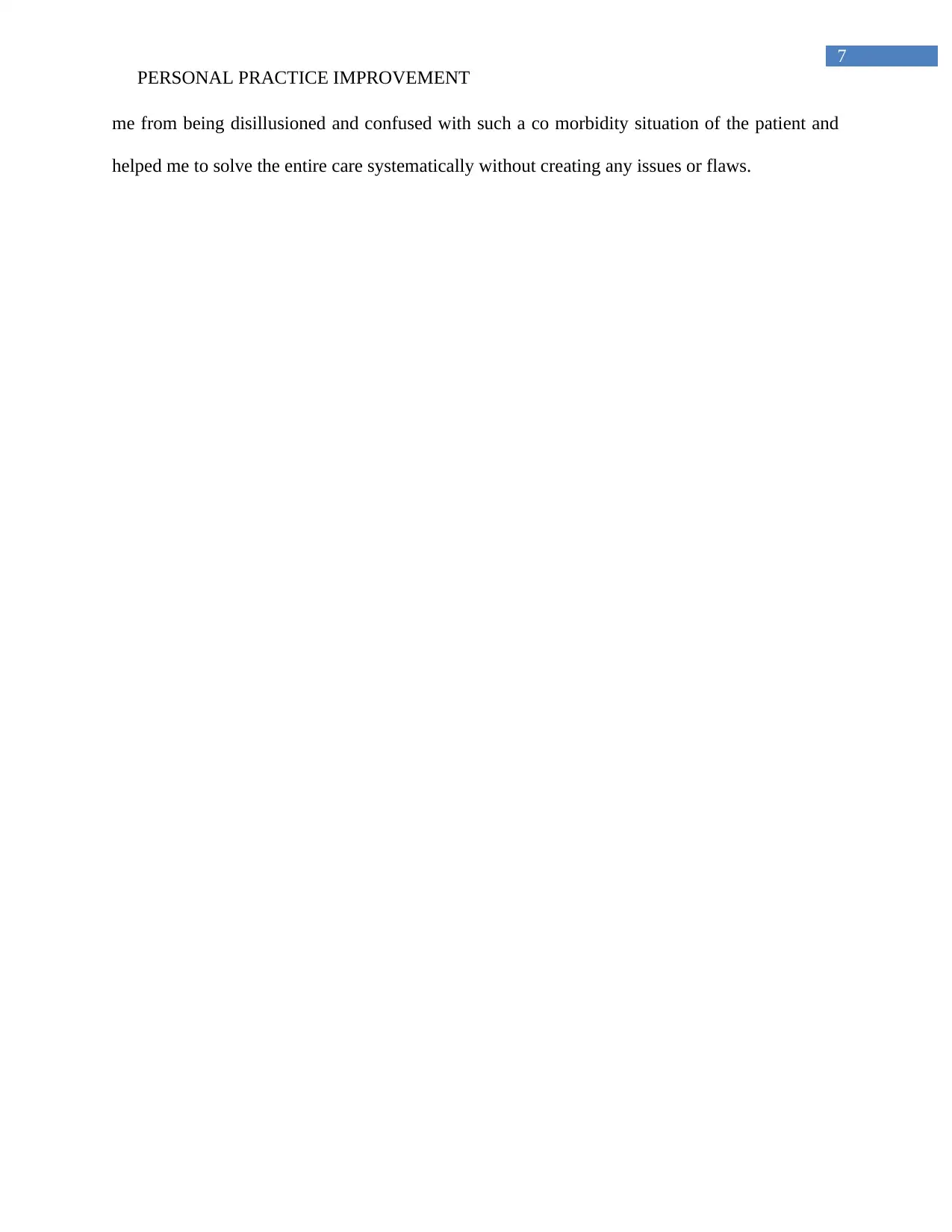
7
PERSONAL PRACTICE IMPROVEMENT
me from being disillusioned and confused with such a co morbidity situation of the patient and
helped me to solve the entire care systematically without creating any issues or flaws.
PERSONAL PRACTICE IMPROVEMENT
me from being disillusioned and confused with such a co morbidity situation of the patient and
helped me to solve the entire care systematically without creating any issues or flaws.
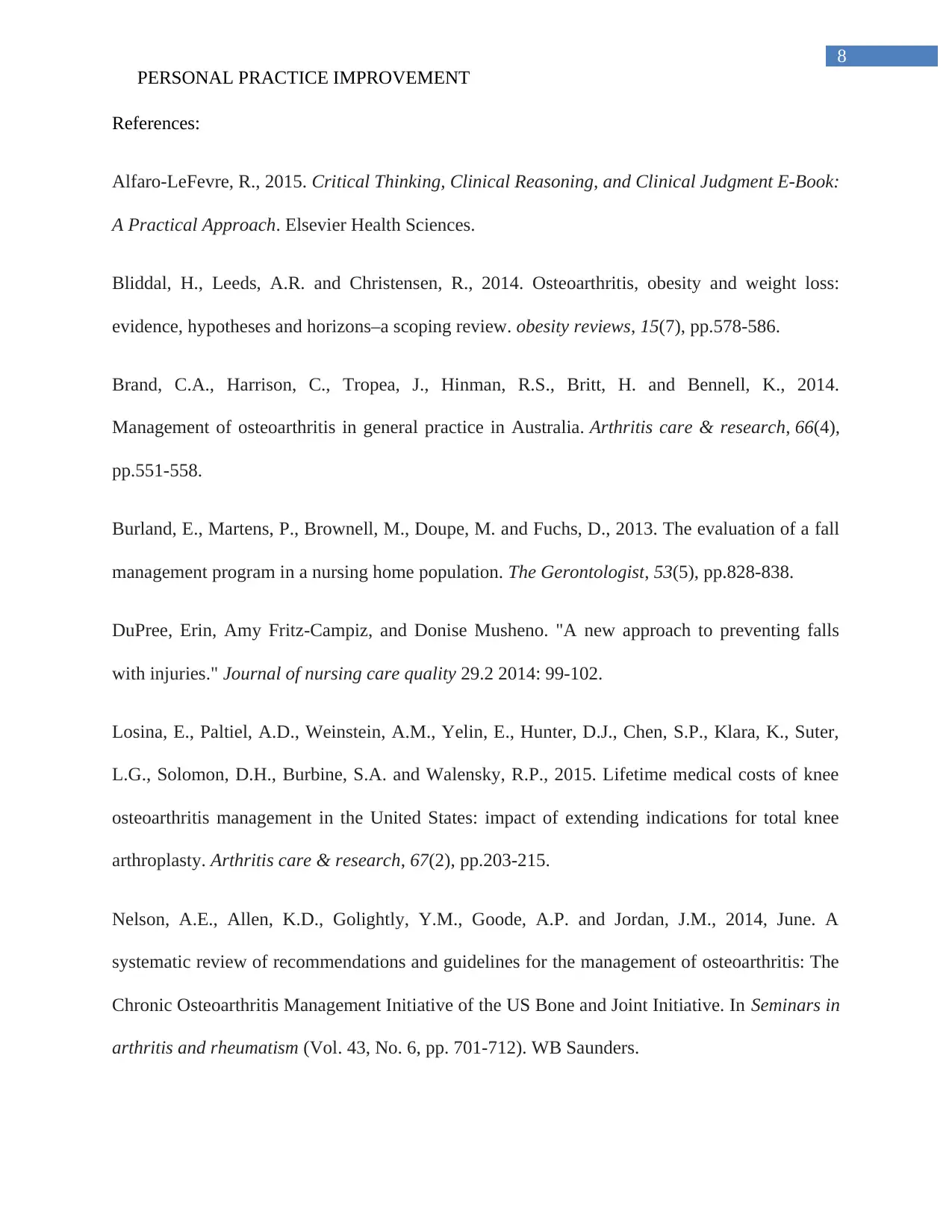
8
PERSONAL PRACTICE IMPROVEMENT
References:
Alfaro-LeFevre, R., 2015. Critical Thinking, Clinical Reasoning, and Clinical Judgment E-Book:
A Practical Approach. Elsevier Health Sciences.
Bliddal, H., Leeds, A.R. and Christensen, R., 2014. Osteoarthritis, obesity and weight loss:
evidence, hypotheses and horizons–a scoping review. obesity reviews, 15(7), pp.578-586.
Brand, C.A., Harrison, C., Tropea, J., Hinman, R.S., Britt, H. and Bennell, K., 2014.
Management of osteoarthritis in general practice in Australia. Arthritis care & research, 66(4),
pp.551-558.
Burland, E., Martens, P., Brownell, M., Doupe, M. and Fuchs, D., 2013. The evaluation of a fall
management program in a nursing home population. The Gerontologist, 53(5), pp.828-838.
DuPree, Erin, Amy Fritz-Campiz, and Donise Musheno. "A new approach to preventing falls
with injuries." Journal of nursing care quality 29.2 2014: 99-102.
Losina, E., Paltiel, A.D., Weinstein, A.M., Yelin, E., Hunter, D.J., Chen, S.P., Klara, K., Suter,
L.G., Solomon, D.H., Burbine, S.A. and Walensky, R.P., 2015. Lifetime medical costs of knee
osteoarthritis management in the United States: impact of extending indications for total knee
arthroplasty. Arthritis care & research, 67(2), pp.203-215.
Nelson, A.E., Allen, K.D., Golightly, Y.M., Goode, A.P. and Jordan, J.M., 2014, June. A
systematic review of recommendations and guidelines for the management of osteoarthritis: The
Chronic Osteoarthritis Management Initiative of the US Bone and Joint Initiative. In Seminars in
arthritis and rheumatism (Vol. 43, No. 6, pp. 701-712). WB Saunders.
PERSONAL PRACTICE IMPROVEMENT
References:
Alfaro-LeFevre, R., 2015. Critical Thinking, Clinical Reasoning, and Clinical Judgment E-Book:
A Practical Approach. Elsevier Health Sciences.
Bliddal, H., Leeds, A.R. and Christensen, R., 2014. Osteoarthritis, obesity and weight loss:
evidence, hypotheses and horizons–a scoping review. obesity reviews, 15(7), pp.578-586.
Brand, C.A., Harrison, C., Tropea, J., Hinman, R.S., Britt, H. and Bennell, K., 2014.
Management of osteoarthritis in general practice in Australia. Arthritis care & research, 66(4),
pp.551-558.
Burland, E., Martens, P., Brownell, M., Doupe, M. and Fuchs, D., 2013. The evaluation of a fall
management program in a nursing home population. The Gerontologist, 53(5), pp.828-838.
DuPree, Erin, Amy Fritz-Campiz, and Donise Musheno. "A new approach to preventing falls
with injuries." Journal of nursing care quality 29.2 2014: 99-102.
Losina, E., Paltiel, A.D., Weinstein, A.M., Yelin, E., Hunter, D.J., Chen, S.P., Klara, K., Suter,
L.G., Solomon, D.H., Burbine, S.A. and Walensky, R.P., 2015. Lifetime medical costs of knee
osteoarthritis management in the United States: impact of extending indications for total knee
arthroplasty. Arthritis care & research, 67(2), pp.203-215.
Nelson, A.E., Allen, K.D., Golightly, Y.M., Goode, A.P. and Jordan, J.M., 2014, June. A
systematic review of recommendations and guidelines for the management of osteoarthritis: The
Chronic Osteoarthritis Management Initiative of the US Bone and Joint Initiative. In Seminars in
arthritis and rheumatism (Vol. 43, No. 6, pp. 701-712). WB Saunders.
⊘ This is a preview!⊘
Do you want full access?
Subscribe today to unlock all pages.

Trusted by 1+ million students worldwide
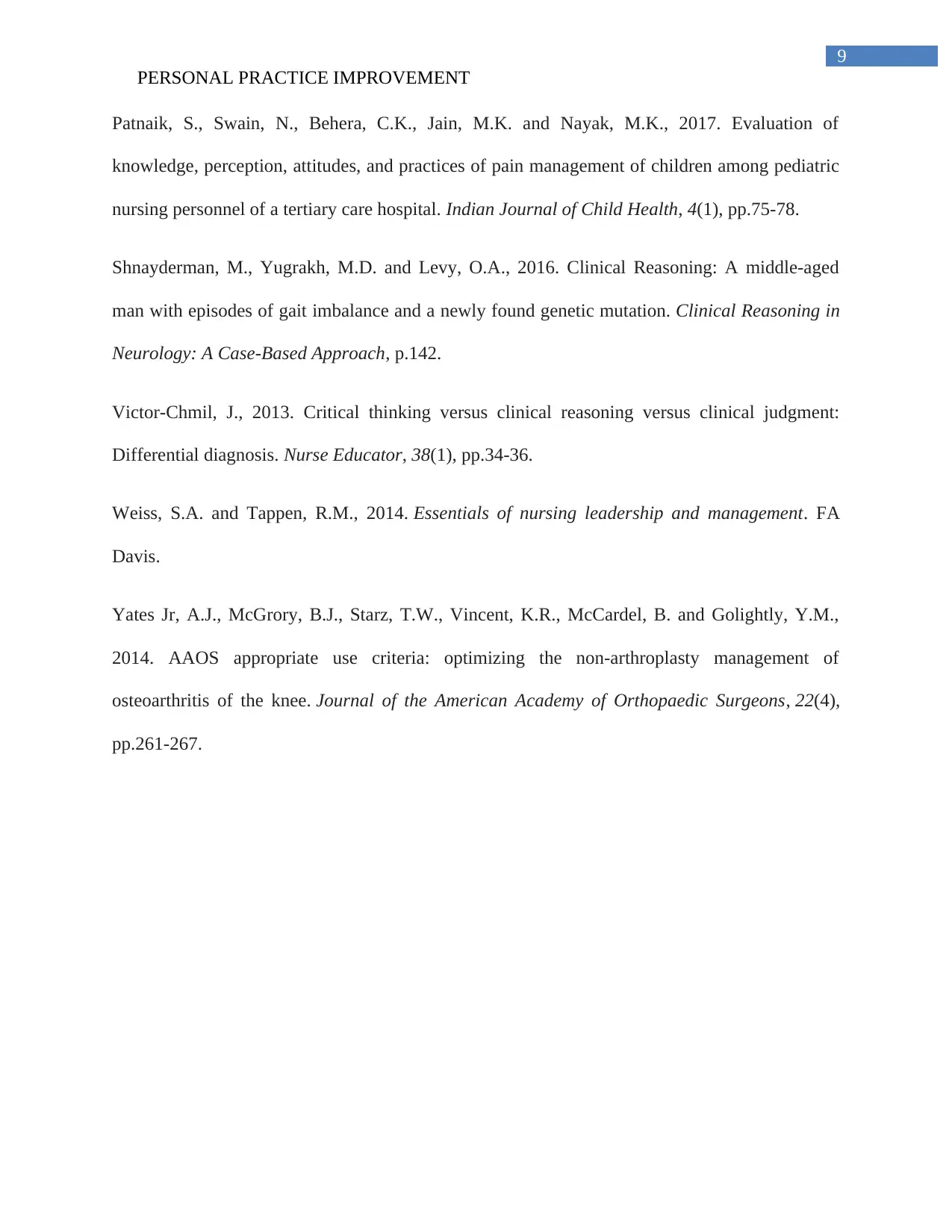
9
PERSONAL PRACTICE IMPROVEMENT
Patnaik, S., Swain, N., Behera, C.K., Jain, M.K. and Nayak, M.K., 2017. Evaluation of
knowledge, perception, attitudes, and practices of pain management of children among pediatric
nursing personnel of a tertiary care hospital. Indian Journal of Child Health, 4(1), pp.75-78.
Shnayderman, M., Yugrakh, M.D. and Levy, O.A., 2016. Clinical Reasoning: A middle-aged
man with episodes of gait imbalance and a newly found genetic mutation. Clinical Reasoning in
Neurology: A Case-Based Approach, p.142.
Victor-Chmil, J., 2013. Critical thinking versus clinical reasoning versus clinical judgment:
Differential diagnosis. Nurse Educator, 38(1), pp.34-36.
Weiss, S.A. and Tappen, R.M., 2014. Essentials of nursing leadership and management. FA
Davis.
Yates Jr, A.J., McGrory, B.J., Starz, T.W., Vincent, K.R., McCardel, B. and Golightly, Y.M.,
2014. AAOS appropriate use criteria: optimizing the non-arthroplasty management of
osteoarthritis of the knee. Journal of the American Academy of Orthopaedic Surgeons, 22(4),
pp.261-267.
PERSONAL PRACTICE IMPROVEMENT
Patnaik, S., Swain, N., Behera, C.K., Jain, M.K. and Nayak, M.K., 2017. Evaluation of
knowledge, perception, attitudes, and practices of pain management of children among pediatric
nursing personnel of a tertiary care hospital. Indian Journal of Child Health, 4(1), pp.75-78.
Shnayderman, M., Yugrakh, M.D. and Levy, O.A., 2016. Clinical Reasoning: A middle-aged
man with episodes of gait imbalance and a newly found genetic mutation. Clinical Reasoning in
Neurology: A Case-Based Approach, p.142.
Victor-Chmil, J., 2013. Critical thinking versus clinical reasoning versus clinical judgment:
Differential diagnosis. Nurse Educator, 38(1), pp.34-36.
Weiss, S.A. and Tappen, R.M., 2014. Essentials of nursing leadership and management. FA
Davis.
Yates Jr, A.J., McGrory, B.J., Starz, T.W., Vincent, K.R., McCardel, B. and Golightly, Y.M.,
2014. AAOS appropriate use criteria: optimizing the non-arthroplasty management of
osteoarthritis of the knee. Journal of the American Academy of Orthopaedic Surgeons, 22(4),
pp.261-267.
Paraphrase This Document
Need a fresh take? Get an instant paraphrase of this document with our AI Paraphraser
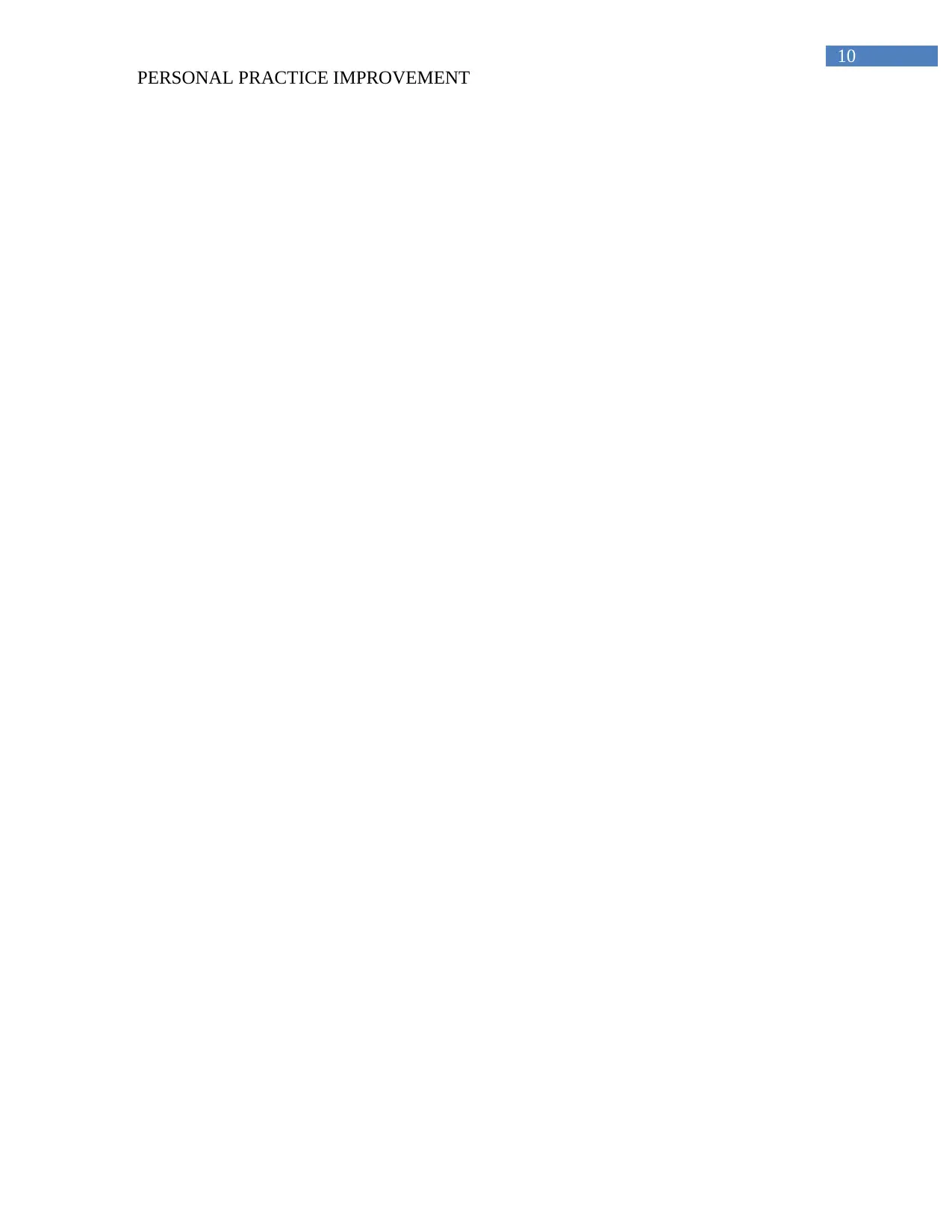
10
PERSONAL PRACTICE IMPROVEMENT
PERSONAL PRACTICE IMPROVEMENT
1 out of 11
Related Documents
Your All-in-One AI-Powered Toolkit for Academic Success.
+13062052269
info@desklib.com
Available 24*7 on WhatsApp / Email
![[object Object]](/_next/static/media/star-bottom.7253800d.svg)
Unlock your academic potential
Copyright © 2020–2025 A2Z Services. All Rights Reserved. Developed and managed by ZUCOL.





